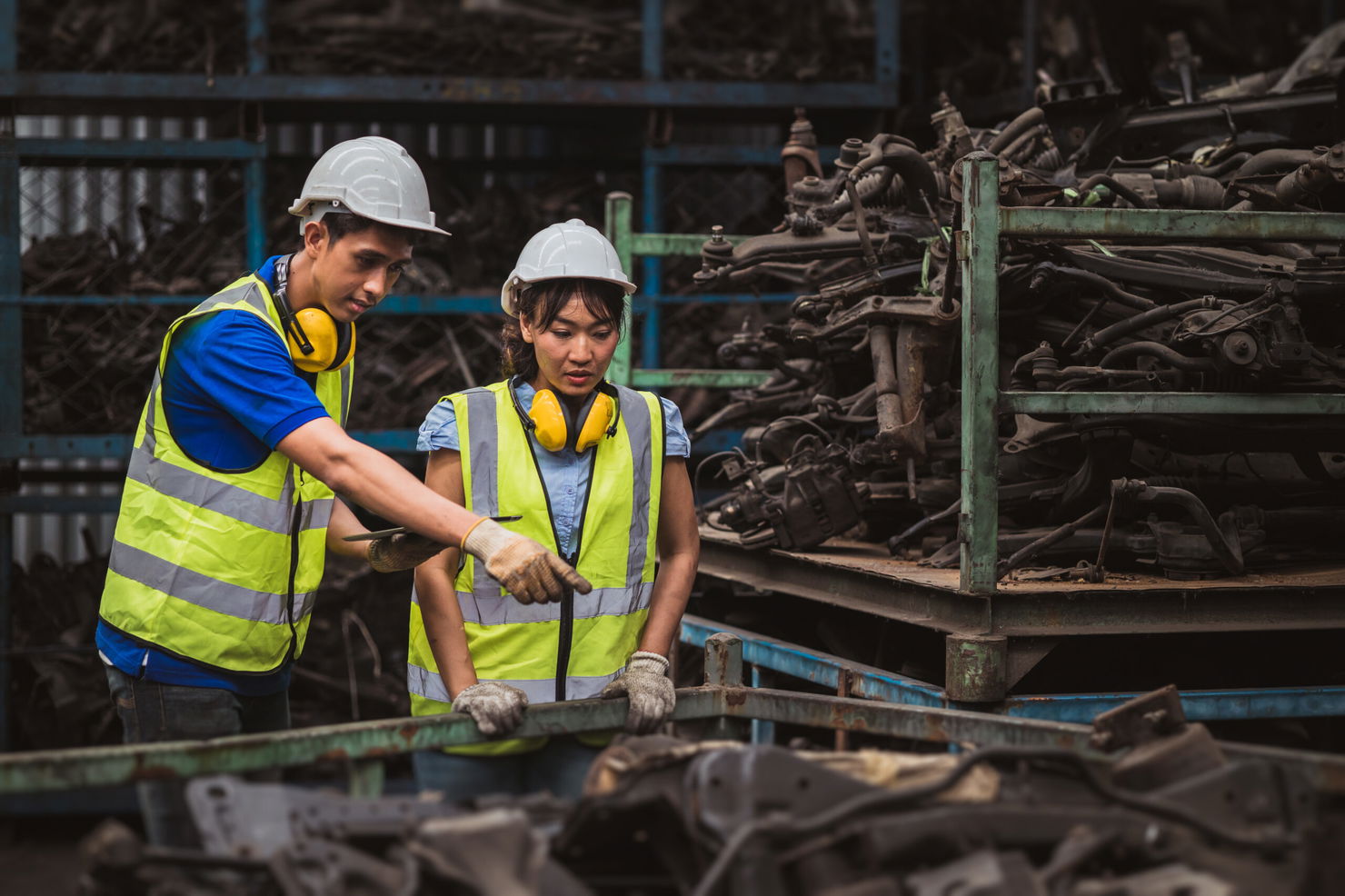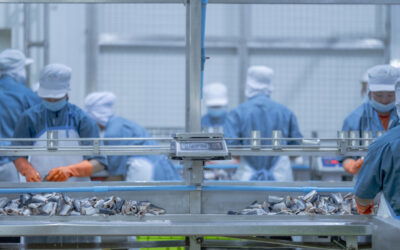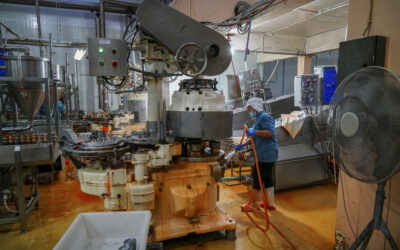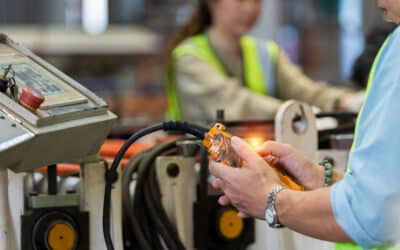Against a backdrop of growing economic, environmental and regulatory pressure, reducing industrial waste has become a strategic issue for any company wishing to reconcile performance and responsibility. Whether it’s lost time, excess energy consumption, unused raw materials or unused waste, every link in the production chain can generate an invisible but real cost.
In this article, we offer you an overview of concrete actions you can take to optimize your industrial processes, based on proven tools, real data, and innovative solutions like those we’re developing at Teeptrak. The aim: to transform every loss into a value-creating opportunity for your industry.
Key figures
“29% productivity gain after implementing TRS monitoring (source: Teeptrak customer case study)”.
industrial aspillage: causes, issues and consequences
Definition and forms of industrial waste
Industrial waste covers all human, material, energy and time resources used without generating value. It manifests itself at different levels:
- Energy overconsumption due to poorly regulated machines or inefficient processes.
- Time : waiting periods between two operations, microstops, unnecessary travel.
- Material raw materials or components that are discarded, unsold or misused.
- Quality Quality: rejects, non-conformities or rework leading to losses.
- Logistics overstock, flow disruptions, delivery errors.
- Workforce under-utilized or misallocated personnel in the production process.
These losses are not always visible on conventional dashboards, but their real cost adds up to millions of euros a year in some industrial companies.
Myth vs. reality
“We often think that waste is only material. In reality, waiting times or human errors often weigh more heavily.”
Economic, environmental and social impacts
| 📌 Type of impact | 📋 Concrete examples | 📊 Measurable consequences |
|---|---|---|
| Economical | Unused machine time, overstock, rejects | Decrease in OEE, loss of sales, additional costs |
| Environmental | Over-consumption of energy, unsorted waste | Increased CO₂ emissions, waste of resources |
| Social | Team demotivation, working conditions | Turnover, lower productivity, disorganization |
Did you know?
“Energy waste represents up to 30% of a production site’s invisible costs.”
Where do losses come from? (stock, energy, time, quality)
According to feedback from theindustrysources of losses are :
- The unplanned stops and micro-stops (up to 25% of total loss)
- The overproduction or excess stock
- The energy consumption consumption
- Quality defects related to processes or personnel
A pie chart can illustrate this average distribution:
-25% Time lost
-20% Energy
-18% Material
-15% Quality
-12% Logistics
– Others
Case study :
“At Nutriset, reducing micro-stops has eliminated one of the biggest production ‘irritants’, with a gain of several points in OEE.”
What are companies’ legal obligations?
AGEC Act, Garot Act and sector regulations
The AGEC law (Anti-Gaspillage pour une Économie Circulaire – Anti-Waste for a Circular Economy) requires companies to progressively transform their practices: fight against waste, better waste recovery, traceability of flows, and reduction of food losses, particularly in the agri-food and catering sectors.
As for the Garot law, it specifically targets the donation of unsold food in supermarkets, and extends to other players. These texts oblige companies to implement concrete actions and justify their commitments.
Sectors concerned :
- Food industry
- Retail & FMCG
- Commercial and institutional catering
- Construction and manufacturing
Expert advice
“Anticipate regulations rather than suffer them: measuring means protecting yourself.”
ISO standards, reporting targets and eco-design
| 📘 Standard | 🎯 Objective | 🛠️ Application |
|---|---|---|
| ISO 14001 | Environmental management | Reducing the ecological footprint |
| ISO 50001 | Energy efficiency | Optimization of consumption |
| ISO 9001 | Quality management | Continuous process improvement |
Reporting objectives :
- Tracking tons of waste generated and recycled
- Energy consumption indicators
- Monitoring the rate of compliant/non-compliant products
- Loss reduction targets per share
The 7 types of waste according to Lean: deciphering the problem
Lean Manufacturing categorizes waste into 7 major types, common in industrial environments:
- Overproduction producing beyond actual demand
- Excessive inventories excess inventory: unnecessary accumulation of products
- Unnecessary movements Unnecessary movements: operators or components in the wrong position
- Waiting time wait between two process steps
- Non-quality defects or touch-ups
- Transport Unnecessary product movements
- Overprocessing unnecessary tasks
Practical tip
“Involve operators in mapping invisible waste (waiting, unnecessary travel, etc.)”.
Reducing industrial waste: concrete levers for action
Diagnosing losses: tools and methods
Before any action is taken, it is essential to identify precisely where, when and why losses occur in the production chain. Several industrial tools are available for this purpose:
- VSM (Value Stream Mapping) Visual mapping of flows and waste.
- Gemba Walk immersion in the field to observe malfunctions in real time.
- Pareto chart Prioritizing the main causes of waste by impact.
These approaches enable us to build a targeted action plan based on concrete data.
Checklist
“Have you identified these 5 types of losses in your industrial flows?
✔️ Downtime
✔️ Overproduction
✔️ Quality defects
✔️ Excess inventory
✔️ Energy loss
Set up performance indicators
Controlling loss reduction is based on key indicators such as :
| 📊 Indicator | 📝 Definition | 🧩 Utility |
|---|---|---|
| TRS | Synthetic Efficiency Ratio | Measures overall equipment productivity |
| Scrap rates | Share of non-conforming products | Monitor quality defects and their impact on production |
Real-time monitoring via connected tools enables performance gaps to be identified immediately.
Mobilizing teams: awareness-raising and training
Reducing waste is also a human project. Team buy-in is a decisive lever: without their involvement, even the best technology remains under-utilized.
A training plan can include :
- Sessions on good anti-waste practices
- Field feedback workshops
- Monitoring of indicators by operators themselves
Point of vigilance
“Technology alone is not enough: team buy-in is key.”
Reduce energy and material waste
Inindustry, energy waste and the loss of raw materials represent significant hidden costs. Several operational levers are available to limit these costs:
- Thermal insulation of equipment to prevent heat loss
- Real-time monitoring of consumption with alerts in case of drift
- Heat recovery and reuse in other process steps
- Control of material waste (cutting, molding, packaging)
- Automatic control of standby zones (compressors, lighting, machines)
An ADEME study estimates that an industrial company can save 10-15% on its energy consumption with simple, targeted actions.
Maintain and enhance equipment reliability
Unmaintained equipment quickly becomes a source of waste (breakdowns, rejects, slowdowns). There are two main approaches:
| 🔧 Maintenance type | ✅ Advantages | ⚠️ Limitations |
|---|---|---|
| Preventive | Reduces the risk of breakdown | Interventions sometimes unnecessary |
| Predictive | Intervenes only in the event of real drift | Requires monitoring tools |
Conditional monitoring, via sensors or systems such as PerfTrak, enables action to be taken at just the right moment: neither too early, nor too late.
Optimize logistics and warehousing
The supply chain is often under-optimized, generating overstock, shortages and invisible waste. Here are the major levers:
- FIFO (First In, First Out) method to avoid expiry or obsolescence
- Kanban system to regulate internal flows
- Reorganization of storage areas to reduce unnecessary travel
- Digitizing inventories to reduce human error
Common mistakes to avoid:
❌ Multiplying “safety” stocks without justification.
❌ Forgetting to link production and supply in real time
❌ Ignoring small flows (parts, consumables) which are often neglected.
The role of real-time monitoring in industrial performance
To sustainably reduce waste, it is essential to visualize losses in real time, quantify them, and then quickly correct them. This is precisely what an industrial monitoring system like TeepTrak can do.
By collecting and centralizing data from your equipment, you can immediately identify anomalies: micro-stops, slowdowns, non-quality, or under-consumption. You no longer manage blindly, but on the basis of real data.
With our customers, this approach has enabled us to gain up to 10 to 15 OEE points in just a few weeks, while empowering our field teams.
Visualization of losses and micro-losses
Before Teeptrak: diffuse unidentified losses
After Teeptrak: micro-stops traced, analyzed and corrected → TRS +12%.
Use case: measurable production gains
“We saw a 29% increase in production volume after installing PerfTrak on a single machine.“
– Customer testimonial, plastics industry
Connected tools and rapid return on investment
Key benefit
“Average ROI observed < 6 months for Teeptrak customers”
How can Teeptrak help you reduce industrial waste?
Our Plug&Play solutions for TRS and loss monitoring
Our tools like PerfTrak and Monitrak enable you to identify precisely where your performance is being lost, thanks to ultra-fast deployment on all your lines.
You gain visibilityand reactivityand above all value.
Example of concrete results with our customers(Stellantis, Hutchinson…)
- “10 to 15 points improvement in OEE in 3 months” – Groupe Hutchinson Hutchinson Group
- “19,000/year in additional revenue per machine” – C.R., Production Manager C.R., Production Manager
- “Elimination of microarrhythmia and irritants” – Nutriset
Train your teams with the TEEPTRAK Academy
Our customers have access to free, ongoing online training to help them master our tools and make continuous improvement a team culture.
Calculate your ROI with our simulator
Access our online tool to estimate the potential gain on your production lines.
🎯 Test the simulator
Reducing food waste: a complementary industrial challenge
Sectors concerned: food processing, catering, distribution
Food waste also affects industry, particularly the :
- Agri-food (production, processing)
- Foodservices (canteens, hospitals, companies)
- Distribution (unsold, out-of-stock, overstock)
Anti-waste best practices and regulatory compliance
Mini checklist :
- Monitoring losses in weight or volume
- Setting up donation partnerships
- Respecting best-before dates
- Optimizing portions and flows
CSR issues and consumer expectations
Consumers expect companies to manage resources responsibly. Taking action against food waste means enhancing the value of products, improving brand image and reducing costs, while complying with new regulations in France and Europe.
Waste as a lever for competitiveness and CSR
Continuous improvement and brand image
The fight against waste is an integral part of a continuous improvement approach. Industrial companies that reduce their losses demonstrate their commitment to responsible production, while reinforcing their credibility with stakeholders.
“We were able to standardize our indicators, empower our teams and improve our employer image.”
– Vincent Perrault, Groupe Eolane
Reducing invisible costs
| 💰 Apparent cost | 📉 Associated hidden cost |
|---|---|
| Waste material | Operator time, over-sorting, waste disposal |
| Machine stopped | Delivery delays, customer dissatisfaction |
| Product non-conformity | Rework, quality testing, penalties |
Responding to regulatory and societal pressures
- More stringent environmental reporting obligations
- Consumers’ growing expectations of transparency
- Label requirements (CSR, ISO, anti-waste, etc.)
- Pressure from customers in calls for tender
FAQ – Answers to frequently asked questions
What's the status of the Garot law?
It now applies to several sectors beyond supermarkets, with the obligation to donate unsold food.
What are the 7 types of waste?
Overproduction, waiting times, transport, overstock, unnecessary movements, defects, over-processing.
What's the best anti-waste site?
Platforms such as Phenix or Too Good To Go redistribute surplus food.
How do I get the anti-gaspi label?
By making a commitment to the relevant authorities (ADEME, DRAAF) and proving its concrete actions against waste.
Practical resources at your disposal
Teeptrak Academy to go further
Need to develop skills inimproving industrial performance? Our Académie Teeptrak offers accessible, free training adapted to your environment.
→ Sign up today to master our tools, understand your losses, and transform your production.





0 Comments